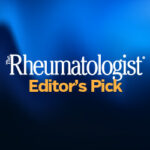Dr. Del Galdo went on to discuss what we have been learning from biosamples collected from VEDOSS patients. In one study, the sera from 64 patients with VEDOSS were tested for interferon (IFN) inducible chemokines. These results were compared with those of healthy controls and patients with systemic sclerosis. The study found that levels of these chemokines were significantly higher in patients with VEDOSS than healthy controls and were at intermediate levels when compared with patients with systemic sclerosis. Skin punch biopsies were also collected from all three study groups, and those from patients with VEDOSS demonstrated evidence of fibrosis and increased collagen bundles within the dermis commensurate with that typically seen in patients with systemic sclerosis.3
The totality of these data suggests that it’s possible to accurately identify patients who are at high risk of progressing to systemic sclerosis and that future disease-modifying treatments should be employed in this therapeutic window.
ILD & Patient Care

Dr. Volkmann
The second speaker was Elizabeth Volkmann, MD, MS, associate professor of medicine, director of the UCLA Scleroderma Program and the founder and co-director of the UCLA Connective Tissue Disease-Related Interstitial Lung Disease (CTD-ILD) Program, UCLA School of Medicine. Dr. Volkmann explained that a fundamental problem in the field is that ILD is the leading cause of death in patients with systemic sclerosis. Although there is an increasing number of therapies to treat this condition, including mycophenolate mofetil, cyclophosphamide, nintedanib, tocilizumab and rituximab, we lack the tools needed to make informed treatment decisions in these cases.
Regarding when to start therapy for ILD, Dr. Volkmann noted that many clinicians take a watch-and-wait approach, in which therapy is only initiated when there is evidence of disease progression. However, taking this approach and relying on such measures as forced vital capacity (FVC) and high-resolution computed tomography (HRCT) chest imaging wastes precious time and risks having the patient accrue irreversible lung damage.
In terms of predicting the risk of ILD progression, Dr. Volkmann explained that we mostly rely on clinical features (i.e., the patient’s gender, race, antibody status, degree of cutaneous involvement and disease duration). But these features do not consistently predict outcomes in individual patients. It is also hard to predict when a patient has both a risk factor for progression and a protective factor that may lessen the likelihood of progression.
Dr. Volkmann clearly stated that, as of this moment, no valid prognostic or predictive biomarkers exist for scleroderma-associated ILD (SSc-ILD). She noted that a prognostic biomarker is a clinical or biological characteristic that provides information on the likely patient health outcome, such as disease progression or mortality, irrespective of the treatment. A predictive biomarker, on the other hand, is a characteristic that identifies individuals who are more likely to respond to a particular intervention.


